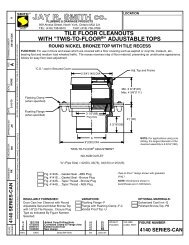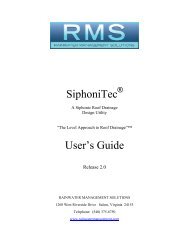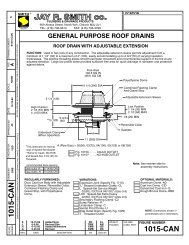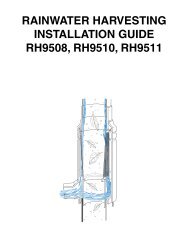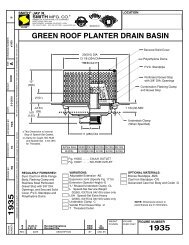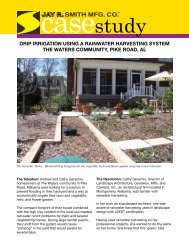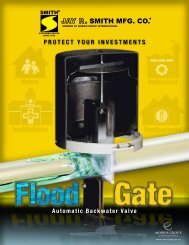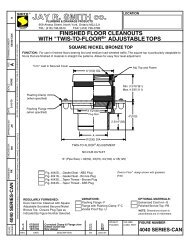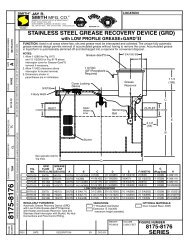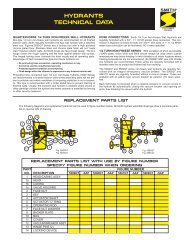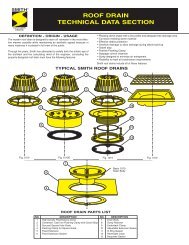Brochure Siphonic Roof Drains - Jay R. Smith MFG Co.
Brochure Siphonic Roof Drains - Jay R. Smith MFG Co.
Brochure Siphonic Roof Drains - Jay R. Smith MFG Co.
Create successful ePaper yourself
Turn your PDF publications into a flip-book with our unique Google optimized e-Paper software.
LEED ® / Green Building Design<br />
The LEED ® (Leadership in Energy and Environment Design)<br />
Green Building Rating System was devised as a voluntary,<br />
consensus-based national standard for developing high-performance,<br />
sustainable buildings. LEED was initially created by the<br />
U.S. Green Building <strong>Co</strong>uncil (USGBC) to establish a common<br />
measurement to define “green building.” It has since grown<br />
into a program aimed at raising awareness of and promoting<br />
integrated “green” building projects.<br />
How does a building become a “green” building Through<br />
design and construction that concentrates on:<br />
<strong>Co</strong>nserving water;<br />
Reducing energy consumption;<br />
Reducing the depletion of natural resources and materials;<br />
Creating a sustainable site;<br />
Use of innovative design;<br />
Improving indoor environmental quality.<br />
To become LEED ® certified, the building is rated by these<br />
six categories. Within each category, points are awarded<br />
based on the LEED Green Building Rating System.<br />
r SS Credit 6.1 “Stormwater Design - Quality <strong>Co</strong>ntrol”<br />
– 1 Point (26 possible points under Sustainable Sites)<br />
<strong>Co</strong>ntrolled flow roof drainage – “To limit disruption of natural<br />
hydrology by reducing impervious cover, increasing on-site<br />
infiltration, reducing or eliminating pollution from stormwater<br />
runoff and eliminating contaminants.”<br />
Did you know that a siphonic roof drain system can reduce<br />
stormwater runoff from the roof<br />
In a siphonic system several roof drain outlets can be connected to a<br />
single vertical discharge pipe reducing the number of discharge points.<br />
And fewer discharge points mean the water can be easily routed for<br />
storage and reuse. This in turn controls the amount of rainwater being<br />
fed into the stormwater systems or runoff area. Once the water is<br />
stored it can be used for landscaping irrigation, toilet and urinal flushing,<br />
and custodial uses.<br />
r WE Credit 3 “Water Use Reduction” – 2-4 Points<br />
(10 possible points under Water Efficiency)<br />
Rainwater harvesting<br />
Water Efficiency – “To further increase water efficiency within<br />
buildings to reduce the burden on municipal water supply<br />
and wastewater systems.”<br />
LEED ® awards points to building designs for a variety of<br />
energy-efficient and environmentally friendly features, from the<br />
installation of radiant heating to reduction of energy consumption,<br />
to grey water recycling, to the use of local building materials<br />
that require less energy to transport. LEED points are not<br />
given to individual products, but to an aggregate of the building<br />
system that saves water, energy, and contributes to a healthy<br />
indoor environment. An example of this is Wal-Mart’s use of<br />
green building designs on a prototype store in Dallas, Texas,<br />
one feature of the design is the capture of rainwater for use<br />
throughout the building and grounds; i.e. rainwater harvesting.<br />
By using <strong>Smith</strong> <strong>Siphonic</strong> <strong>Roof</strong> <strong>Drains</strong> in a siphonic design,<br />
LEED ® points can be awarded for using recycled material<br />
(cast iron), reducing site preparation (less buried pipe), and<br />
extra points can be awarded by using “Innovation and Design”<br />
concepts. Additional points can be awarded if the siphonic<br />
system is used for rainwater harvesting. For more information<br />
on how siphonic systems can be used in rainwater harvesting,<br />
see page A.10<br />
Environmental Design Credits<br />
The benefit of using <strong>Smith</strong> <strong>Siphonic</strong> <strong>Roof</strong> <strong>Drains</strong> in a siphonic design<br />
is that this concept helps achieve the ultimate goal of USGBC: to<br />
promote buildings that are environmentally responsible, profitable and<br />
a healthy place to live and work. Here’s how to get design credit:<br />
r SS Credit 5.1:Site Development - “Protect or Restore Habitat” –<br />
1 Point (26 possible points under Sustainable Sites)<br />
Reduced, shallower trenching – “To conserve existing natural areas<br />
and restore damaged areas to provide habitat and promote<br />
biodiversity.”<br />
Did you know that a siphonic roof drain system requires less site<br />
preparation<br />
In a siphonic system there is a de-pressured flow (a higher flow capacity<br />
since flow is a full-bore) which means there is much more flexibility<br />
where pipe routing is concerned – thus the pipe work can be run just<br />
horizontally below the roof rather than below ground; this means there<br />
is less need for groundwork such as site trenching, bedding, and<br />
backfilling.<br />
A.9<br />
Did you know that a siphonic roof drain system can be used<br />
successfully with water harvesting<br />
A siphonic system allows for piping to a water harvesting system so<br />
that it can be stored and used for non-potable applications such as in<br />
irrigation, toilet and urinal flushing, mechanical systems, and custodial<br />
uses.<br />
r “Recycled <strong>Co</strong>ntent”<br />
Did you know that most cast iron is “green”<br />
Most cast iron drainage products use 100% post-consumer recycled<br />
materials and can be re-melted and recycled after their useful life. Such<br />
is true with all <strong>Jay</strong> R. <strong>Smith</strong> Mfg. <strong>Co</strong>., cast iron, plumbing and drainage<br />
products and our siphonic roof drains.<br />
r ID Credit 1 “Innovation in Design” – 1-5 Points<br />
(6 possible points under Innovation & Design Process)<br />
Achieve Measureable Environmental Performance – “Award points<br />
for exceptional performance above the requirements set by the<br />
LEED Green Building Rating System.”<br />
Did you know that a siphonic roof drain system is an innovative<br />
design<br />
A siphonic roof drain system allows for smaller diameter piping and<br />
more flexibility where pipe routing is concerned. These characteristics<br />
enable significant savings of time and money in the construction of<br />
large industrial or commercial buildings. The need for vertical rainwater<br />
piping inside a building can be eliminated, saving approximately 1/2<br />
a square meter per stack. This allows greater flexibility in the use of<br />
space within open-plan buildings, permitting larger uncluttered areas<br />
in large public structures. If used in conjunction with a rainwater<br />
harvesting system, there can be increases in water use reduction<br />
percentages.<br />
<strong>Jay</strong> R. <strong>Smith</strong> Mfg. <strong>Co</strong>. <strong>Co</strong>pyright © 2009 All Rights Reserved



